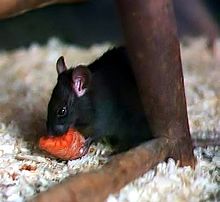October has been a very active month for the Lab. Two more papers are now on early view of Journal of Ecology. Congratulations to the two PhD students who lead them as first authors (Lucía Latorre, from the LES, and Fran G. Gonzalvez, from Miguel A. Rodríguez-Gironés' Lab at the EEZA, Almería)!
Latorre, L., Larrinaga A.R., Santamaria, L. Combined impact of two exotic herbivores on different life-stages of an endangered plant endemism, Medicago citrina. Journal of Ecology.
Gonzalvez, F.G., Santamaría, L. & Rodríguez-Gironés M.A. Flowers attract weaver ants to deter pollen thieves. Journal of Ecology.
30.10.12
26.10.12
Our Lab supports Open Access
Even if we have difficulties to afford it, at current prices...
Have a look at this video that explains, with cunning and humour, the why's and how's of Open Access Journals
Have a look at this video that explains, with cunning and humour, the why's and how's of Open Access Journals
Rats resistant to control
A still-ongoing study reported in BBC News and Science Daily shows that repeated control using rodenticides (such as Bromadiolone
and Difenacoum) is causing the evolution of resistance in rats: up to
75% of rats in Bristol, Gloucestershire and Wiltshire (UK) had built up a
resistance. Besides representing a telling example of real-time evolution, these results suggest that traditional approaches to pest control may - by ignoring evolutionary processes, backfire and promote further the invasion process (as bites become food for resistant rat individuals and rodenticides harm their predators).
Rats are the most ubiquitous invasive species on insular ecosystems, being present in almost 90% of the world's islands. At the LSE, the PhD thesis of Lucía Latorre focuses on the impact and management of "invasion complexes", groups of co-occurring invasive species that establish positive or negative inter-relations (e.g., as predator and prey - such as black rats and feral cats). We'll keep you updated of her results.
Rats are the most ubiquitous invasive species on insular ecosystems, being present in almost 90% of the world's islands. At the LSE, the PhD thesis of Lucía Latorre focuses on the impact and management of "invasion complexes", groups of co-occurring invasive species that establish positive or negative inter-relations (e.g., as predator and prey - such as black rats and feral cats). We'll keep you updated of her results.
17.10.12
Two new papers
Two new publications of the LSE are now out.
One has just come in paper (see the cover of the special issue, with pics of Cíes island, Eyed Lizard and Corema fruits in the center and lower-left corner):
Piazzon, M., Larrinaga, A.R., Rodríguez-Pérez, J., Latorre, L., Navarro, L., Santamaría, L. Seed dispersal by lizards in a continental island: predicting inter-specific variation in seed shadows based on adultplant distribution and lizard movement patterns. Journal of Biogeography.
And the other is available on early view:
Viana, D.S., Santamaria, L., Michot, T.C., Figuerola, J. (2012) Migratory strategies of waterbirds shape the continental-scale dispersal of aquatic organisms. Ecography.
One has just come in paper (see the cover of the special issue, with pics of Cíes island, Eyed Lizard and Corema fruits in the center and lower-left corner):
Piazzon, M., Larrinaga, A.R., Rodríguez-Pérez, J., Latorre, L., Navarro, L., Santamaría, L. Seed dispersal by lizards in a continental island: predicting inter-specific variation in seed shadows based on adultplant distribution and lizard movement patterns. Journal of Biogeography.
And the other is available on early view:
Viana, D.S., Santamaria, L., Michot, T.C., Figuerola, J. (2012) Migratory strategies of waterbirds shape the continental-scale dispersal of aquatic organisms. Ecography.
16.10.12
In Brussels, for a meeting of the BiodiversityKnowledge Project
The Laboratory of Spatial Ecology participates in the project, bringing in its expertise in collaborative adaptive management. At this point, we are actively engaged in the Marine Biodiversity case study, which incorporates a comparative use of the three methodologies outlines in the NoK protocol (expert assessment, systematic review and collaborative adaptive management).
11.10.12
Pablo Guitian joins us to complete the sampling of Coastal Juniper at Cabrera Archipelago
Pablo Guitian joined us last week to complete the sampling of the last populations of Coastal Juniper (Juniperus phoenicea turbinata) at Conillera Islet, Cabrera Archipelago, and desitgn the autumn-winter survey and experiments of project GENSABINA.
Conillera's terrein was about the roughest we encountered to date at the islands, but we enjoyed the great weather, the calmed sea - and the early bloom of a few individuals of Narcisus tazetta.
Conillera's terrein was about the roughest we encountered to date at the islands, but we enjoyed the great weather, the calmed sea - and the early bloom of a few individuals of Narcisus tazetta.
Asier and Pablo georeferencing Coastal Junipers at Conillera. Behind are the L'Esponga, Na Plana, Na Pobra and Na Foradada Islets and, far away, the highest peaks of Mallorca's Tramuntana Mountains.
Subscribe to:
Posts (Atom)





